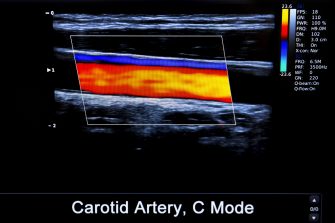Study Shows Less Risk to Internal Carotid Artery Strains With Spinal Manipulation than Normal ROM
 Chiropractic care is utilized most commonly for the treatment of neck and back pain. Many patients have experienced positive outcomes. While doctors of chiropractic are well trained to recognize and consider a patient’s risk factors before recommending a course of treatment, some who may have limited knowledge of the safety of the treatments provided have concerns about a risk of stroke.
Chiropractic care is utilized most commonly for the treatment of neck and back pain. Many patients have experienced positive outcomes. While doctors of chiropractic are well trained to recognize and consider a patient’s risk factors before recommending a course of treatment, some who may have limited knowledge of the safety of the treatments provided have concerns about a risk of stroke.
Estimates based on current data remain low, only 1 in a million; yet, due to the serious nature of strokes, researchers continue to conduct studies to examine if Spinal Manipulative Therapy (SMT) is truly a cause. Their focus is directed primarily towards the vertebral artery and internal carotid artery (ICA).
A group of researchers published their findings in a 2015 issue of the Journal of Manipulative and Physiological Therapeutics which looked specifically at the Internal Carotid Artery Strains During High-Speed, Low-Amplitude Spinal Manipulations of the Neck. Their hypothesis was “that stretching of the ICA during cervical SMTs does not cause strains in excess of those experienced during normal everyday movements such as extending the head and neck when looking up at the sky or when rotating the head while backing out a car from the driveway.” At the time of the study, there was no existing “data on the mechanics of ICA during neck manipulation” to determine if this could be true.
Researchers tested strain to the ICA during neck spinal manipulative treatments as compared to normal range of motion (ROM) or other diagnostic testing of the head and neck. They evaluated strain during 10 different neck treatments using various adjustment techniques then 8 head/neck ROM tests. All treatments and tests were performed on both sides and repeated 3 times. This was repeated by 2-4 licensed chiropractors per subject. In total, 5 chiropractors performed 1,080 strain measurements during SMT and 864 during ROM testing. The chiropractors ranged from 3 to 42 years of experience.
Results of the strain measurements showed that the maximum strain on the ICA is actually greater for ROM testing than spinal manipulation. This held true across the board. The “maximal strains (in percentage of the neutral length) for all ICAs and each chiropractor during SMT” was 15.8. However, it was 94.5 for ROM testing.
Researchers concluded “SMTs are less likely to produce stretch-induced damage to the ICA than normal, everyday head and neck movements involving the full possible ROM. Therefore, cervical SMT, as performed by the trained doctors of chiropractic in this study, did not appear to place undue strain on the ICA and thus does not seem to be a factor in ICA injuries.”
Chiropractors have extensive education and training from nationally accredited, 4-year doctoral graduate school programs. Their rigorous curriculum requires a minimum of 4,200 hours of classroom, laboratory, and clinical internship, which is comparable to MD and DO medical schools. You can find more information about chiropractic education, here.
If you or a loved one are experiencing back or neck pain, you can be confident that chiropractic care is both safe and effective. You can also find more information through our Articles & Research webpage. If you have questions or concerns, feel free to ask your chiropractor for more information about their training and the services they provide. If you don’t have a local doctor, find one near you at https://www.tnchiro.com/find-a-doctor/ .
SOURCE: Internal Carotid Artery Strains During High-Speed, Low-Amplitude Spinal Manipulations of the Neck By: Walter Herzog, PhD, Conrad Tang, DC, Tim Leonard, PhD Published in Journal of Manipulative and Physiological therapeutics, November–December, 2015, Volume 38, Issue 9, Pages 664–671